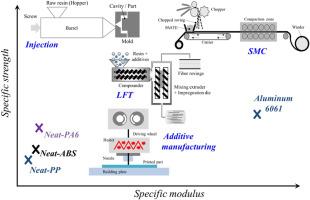加工驱动的非连续碳纤维增强复合材料力学性能
IF 11.6
2区 材料科学
Q1 CHEMISTRY, PHYSICAL
引用次数: 0
摘要
不连续碳纤维增强聚合物(DFRPs)的力学性能受到材料选择和加工过程中纤维形态变化的显著影响。本研究评估了四种制造技术:注射成型,长纤维热塑性塑料(LFT),片状成型化合物(SMC)和增材制造(AM)。该研究考察了这些技术如何影响纤维对中、长径比和体积分数,以及这些因素如何影响拉伸强度、刚度和其他机械性能。LFT和SMC表现出增强的拉伸性能,因为它们能够在加工过程中保持纤维长度和保持准对齐取向。另一方面,由于纤维磨损、随机排列和弱界面结合,注射成型和AM具有明显有限的负载传递效率。使用微观力学模型,如混合规则和基于取向张量的框架,可以更深入地了解由工艺引起的微观结构差异。除了机械行为,这项研究还探讨了可回收性和可持续性的趋势。研究表明,与热固性系统(如SMC)相比,基于热塑性塑料的工艺(LFT和注塑成型)在能耗和闭环材料再利用方面具有显着优势。每种技术都与轻量化、抗冲击或高通量复合材料制造有关。这些技术在特定于应用程序的流程建议中给出。最后,强调了dfrp的主要局限性,包括有限模量和疲劳脆弱性。提出了未来的研究方向,重点是混合加固策略和恶劣环境下的耐久性。总体而言,研究结果为定制不连续CFRP系统提供了全面的指导,以满足高性能、可持续复合材料应用的不断发展的需求。本文章由计算机程序翻译,如有差异,请以英文原文为准。

Processing-driven mechanical performance of discontinuous carbon fibre-reinforced composites
The mechanical performance of discontinuous carbon fiber-reinforced polymers (DFRPs) is significantly influenced by material selection and changes in fiber morphology resulting from processing. This study evaluates four fabrication techniques: injection molding, long fiber thermoplastics (LFT), sheet molding compounds (SMC), and additive manufacturing (AM). The investigation examines how these techniques affect fiber alignment, aspect ratio, and volume fraction and how these factors influence tensile strength, stiffness, and other mechanical properties. LFT and SMC exhibit enhanced tensile properties due to their ability to preserve fiber length and maintain quasi-aligned orientation during processing. Injection molding and AM, on the other hand, have significantly limited load transfer efficiency due to fiber attrition, random alignment, and weak interfacial bonding. Using micromechanical models, such as the rule of mixtures and orientation tensor-based frameworks, provides more insight into the differences in microstructure caused by the processes. Beyond mechanical behavior, this study explores trends in recyclability and sustainability. The study reveals that thermoplastic-based processes (LFT and injection molding) offer notable advantages in terms of energy consumption and closed-loop material reuse compared to thermoset-based systems, such as SMC. Each technique is linked to lightweight, impact-resistant, or high-throughput composite manufacturing. These techniques are presented in application-specific process recommendations. Finally, the key limitations of DFRPs, including limited modulus and fatigue vulnerability, are highlighted. Future research directions focused on hybrid reinforcement strategies and durability in harsh environments are also proposed. Overall, the findings provide comprehensive guidance on tailoring discontinuous CFRP systems to meet the evolving demands of high-performance, sustainable composite applications.
求助全文
通过发布文献求助,成功后即可免费获取论文全文。
去求助
来源期刊

Carbon
工程技术-材料科学:综合
CiteScore
20.80
自引率
7.30%
发文量
0
审稿时长
23 days
期刊介绍:
The journal Carbon is an international multidisciplinary forum for communicating scientific advances in the field of carbon materials. It reports new findings related to the formation, structure, properties, behaviors, and technological applications of carbons. Carbons are a broad class of ordered or disordered solid phases composed primarily of elemental carbon, including but not limited to carbon black, carbon fibers and filaments, carbon nanotubes, diamond and diamond-like carbon, fullerenes, glassy carbon, graphite, graphene, graphene-oxide, porous carbons, pyrolytic carbon, and other sp2 and non-sp2 hybridized carbon systems. Carbon is the companion title to the open access journal Carbon Trends. Relevant application areas for carbon materials include biology and medicine, catalysis, electronic, optoelectronic, spintronic, high-frequency, and photonic devices, energy storage and conversion systems, environmental applications and water treatment, smart materials and systems, and structural and thermal applications.
 求助内容:
求助内容: 应助结果提醒方式:
应助结果提醒方式:


